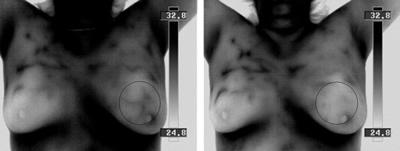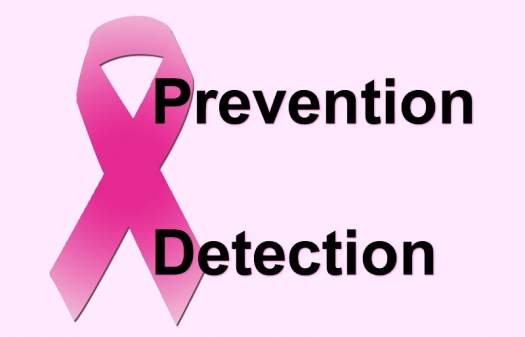We hear so much about the importance of early detection for breast cancer to "save lives," but what women really want is prevention. Early detection is not prevention. Prevention is supported through education and risk factor management. Now more than ever, women can capitalize on the preventive resources and tools available on their journeys to better breast health.
Any test that looks for cancer, even early, is an "after the fact" detection test: cancer has already developed. Women don't want to detect breast cancer early: they want to prevent it. Women need a "before the fact" test.
Detection Focus
"After the Fact" tests look for signs suggestive of cancer:
- Mammography, Basic Thermography, Ultrasound
- Magnetic Resonance Imaging (MRI)
- Breast Specific Gamma Imaging (BSGI)
- Positron Emission Tomography (PET Scan)
While these tests are commonly called “diagnostic,” they are NOT, as only pathology can diagnose cancer by way of studying a tissue (biopsy) sample under a microscope.
Of these tests, only Basic thermography is without radiation, injection or contact with the body.
Although mammography is referred to as the "gold standard" for breast cancer screening, breast thermography is becoming more commonplace, with Dr. Christiane Northrup referring to it as "The Best Breast Test" in part because of its ability to "detect breast cell anomalies long before mammography can detect cancer."
Prevention Focus
"Before the Fact" tests look for signs suggestive of cancer's pre-cursors/ risk factors causing inflammation:
Breast Cancer Does Not Start in the Breasts
Do you know that:
- ... breast cancer does not start in the breasts, but rather as (gut) dysfunction in the body or dental-related issues from which inflammation drains into the breasts lymphatically?
- ... the lymphatic system collects waste products from the body with “trash trucks” navigating through the underarms to the heart?
- ... the majority of the lymphatic highway system drains through the left side?
- ... the majority of breast cancers are in the left breast?
So if the head and body are the “faucet” that drain into the breasts, “the basins of the sink, then can women support prevention by turning off the faucet?
The Role of Advanced Thermography/Risk Assessing Thermal Imaging (RATI)
While all thermographers seek to support early detection by revealing signs consistent with active cancer (neoangiogenesis) years before masses are large enough to be revealed by mammography, the vast majority of thermography is Basic Thermography rather than Advanced Thermography/RATI.
The benefit of Advanced Thermography/RATI lies in its ability to reveal potential sources of inflammatory processes in the body draining lymphatically into the breasts early enough to intervene and reverse risk, supporting prevention. This requires sensitive thermal imaging camera technology with B&W images – not color.
Not all thermography is the same, and few thermographers provide RATI, with Thermobiological Risk Ratings on a scale of 1-5 for each breast, a Hormonal Grade to indirectly assess breast estrogen stimulation – the highest risk factor for developing cancer – and images not only in color, but also B&W, providing greater sensitivity and earlier warning signs of inflammation than in color.
For a RATI provider near you, consider: International Academy of Clinical Thermology's Links to Qualified Thermography Centers and Eagle Institute of Clinical Thermology's Find A Center Near You page.
Be the Cure. Seek Prevention.
Seek to learn the sources of inflammation in your life and body. Address and reverse chronic inflammation, the precursor of many conditions. Consider Advanced Thermography, preventive education and lifestyle modifications to do so.
Since the causes of inflammation and effective risk reduction strategies are unique to each individual, it is important to individualize the education and prevention strategies for each woman based on her thermal imaging findings, symptoms, lifestyle, history, intuition, and common sense, and employing functional health professionals as needed for further testing/evaluation and development of intervention/prevention plans.
Successes at The Thermogram Center, Inc. in Colorado: Subsequent to their initial RATI sessions, the majority of women who follow recommended risk reduction strategies see a decrease in inflammation levels in the breasts: prevention!
Self-Care & Prevention Education
To support self-care, the book, "Better Breast Health – for Life!" is available from The Thermogram Center, Inc. as a downloadable PDF version completely free-of-charge and paperback versions are available to order.
The publication covers nearly 40 cancer risk factors that contribute to the development of cancer in men and women, not just breast cancer, with risk reducing strategies spanning environmental, hormonal, dietary, immunity, lifestyle and dental risk factors. It also includes Risk Factor and Actions Checklist Worksheets to track one’s progress. It’s self-empowering and free to all!
Is a woman's breast cancer risk factor identification, education, and management her best offense towards prevention? The potential is certainly empowering and counter to the myth that women are powerless... just waiting to be diagnosed with breast cancer.
Reducing risk isn't rocket science, but requires preventive education, healthy choices and consistent action over time.
breastthermalimagebeforeafter.jpg

Image courtesy of Tirza Derflinger
Comparison of breast thermal images before (left) and after (right) treatment; note change in lymphatic congestion in circled area.
This 54 year old client had no breast complaints, and was post menopausal. Her initial breast series included the thermal image at left, which includes an assymetrical vascularity in the left breast, circled. The thermal findings associated with this vascularity contributed to a left breast rating of TH 4.
Because the client was already working with an acupuncturist and suspected lymphatic congestion, she asked her acupuncturist to focus on clearing the left breast. The thermal image at right resulted 5 months later.
For more information on RATI in Colorado and the book, Better Breast Health – for Life!, visit The Thermogram Center, Inc.



